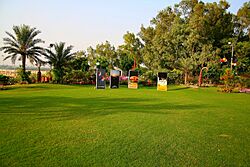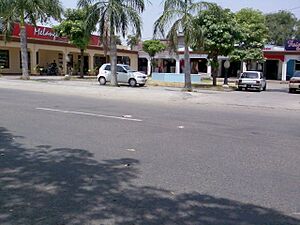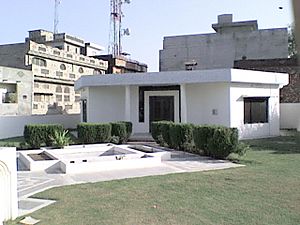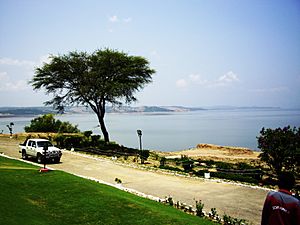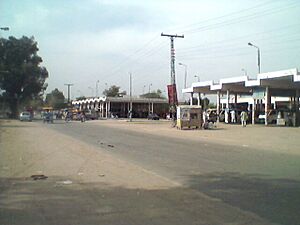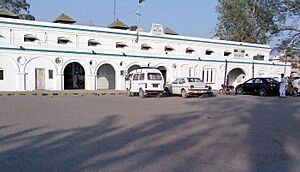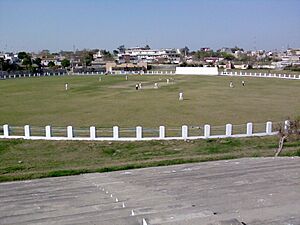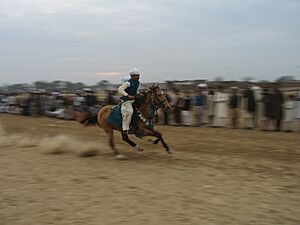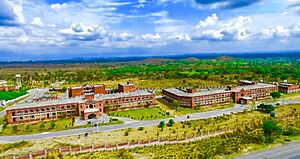Jhelum facts for kids
Quick facts for kids
Jhelum
جہلم
|
|
|---|---|
|
City
|
|
|
Clockwise from top: Masjid Afghana, Tareekh-e-Jhelum book cover, Cantonment Square, CMH Mosque and Zamir Jaffri Cricket Stadium
|
|
| Nickname(s): | |
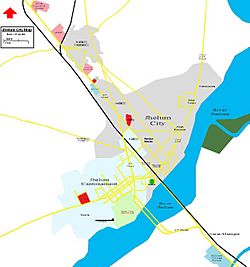
Map of Jhelum City
|
|
|
Location in Punjab, Pakistan
|
|
| Country | |
| Province | |
| Division | Rawalpindi |
| District | Jhelum |
| Founded by | Before BC |
| Union Councils | 7 |
| Area | |
| • City | 22.5 km2 (8.7 sq mi) |
| Elevation | 233 m (768 ft) |
| Population
(2023)
|
|
| • City | 291,022 |
| • Rank | 44th, Pakistan |
| • Demonym | Jhelumi |
| Languages | |
| • Official | Punjabi, Urdu |
| Time zone | UTC+5 (PKT) |
| Postal code |
49600
|
| Dialling code | 0544 |
Jhelum is a city in Pakistan. It is located on the west bank of the Jhelum River. This city is in the northern part of Punjab province. Jhelum is the 44th largest city in Pakistan based on its population.
The city is famous for its many soldiers. They served in the British Army before Pakistan became independent. Later, they joined the Pakistan armed forces. Because of this, Jhelum is known as the City of Soldiers. It is also called the Land of Martyrs and Warriors.
Jhelum is close to where a famous battle happened long ago. This was the Battle of the Hydaspes between Alexander the Great and King Porus the Elder. Some people think Jhelum City might have been the capital of Porus's kingdom, Paurava. A city named Bucephala was built nearby to remember Alexander's horse, Bucephalus, who died there.
Other important places nearby include the 16th-century Rohtas Fort. There is also the Tilla Jogian complex of old temples. The old Grand Trunk Road from the 16th century goes through Jhelum. In 2017, Jhelum had a population of 190,425 people. The city's name comes from "Jal" (pure water) and "Ham" (snow). This is because the river's water comes from the snowy Himalayas. Jhelum has factories that make tobacco, wood, marble, glass, and flour. It is also close to the capital city of Pakistan.
Contents
What's in a Name? The Meaning of Jhelum
The name Jhelum has a few interesting stories behind it. Anjum Sultan Shahbaz wrote about these in his book, Tareekh-e-Jhelum.
- Some people believe that in ancient times, Jhelumabad was called Jalham. The word Jhelum might come from "Jal" (meaning pure water) and "Ham" (meaning snow). This name would refer to the river's water, which starts in the snowy Himalayas.
- Another idea is that a ruler named "Dara-e-Azam" placed his flag by the river after winning battles. He called the spot "Ja-e-Alam," which means "Place of the Flag." Over time, "Ja-e-Alam" became "Jhelum."
- A traditional story says that Saeed Bin Abi Waqas, a brother of Sa`d ibn Abi Waqqas, visited Jhelum while traveling to China to teach about Islam. When he saw the city's reflection in the river, he said, "هذا جهيلم" (this is Jhelum). This phrase means "City beside the river, in full moonlight."
- Even Ahmed Shah Abdali, a famous ruler, used "Jheelum" instead of "Jhelum" in his diary.
Jhelum's Long History
Ancient Times
The first people to live in the Jhelum area were likely the Rajput, Gujjars, and Labana tribes. They lived in the Salt Range and the northern plateau.
A very important event in Jhelum's history was the Battle of the Hydaspes. This battle happened between Alexander the Great and a local ruler named Porus the Elder. Another king, Abisares, who ruled in the mountains beyond the Hydaspes River, sent messages to Alexander. Alexander let Abisares keep his kingdom and even made it bigger.
Porus's kingdom, Paurava, was on the left side of the Jhelum River. The Gakhars were an early group of conquerors from the west. They still live in the mountains north of the Tilla range. The Gakhars were powerful during the early Muslim era. They managed to stay independent for a long time in Jhelum and the nearby Rawalpindi area.
Medieval Period
In 997 CE, Sultan Mahmud Ghaznavi took control of the Ghaznavid dynasty. He conquered the Shahi kingdom in Kabul and then the Punjab region, including Jhelum. Later, the Delhi Sultanate and the Mughal Empire ruled this area. The Punjab region became mostly Muslim because of Sufi saints who taught about Islam.
The Mughals were Persianized Turks. They were related to both Timur and Genghis Khan. They made the Persian culture stronger in Muslim India. The Mughals encouraged local people like the Jats and Gakhars to convert to Islam. Many Jats became Muslims because of the Mughals.
After the Mughal Empire became weaker when Aurangzeb died, the Durrani Empire took over. But the Sikhs eventually pushed them out.
Later Periods and British Rule
After the Mughal Empire declined, the Afghans controlled the region. When Afghan rule weakened, the new Sikh Empire took over Jhelum District in 1808. They captured it from the Gakhar ruler, Raja Sultan Muqarrab Khan.
In 1849, Jhelum became part of the British Empire, along with other Sikh lands. The British took control of Jhelum with help from the local Gakhars, who did not like Sikh rule. In 1857, soldiers from the 14th Native Infantry in Jhelum rebelled. They fought bravely against British forces. However, they left during the night and were later caught by Kashmiri authorities. They were then given to the British and executed.

During British rule, Jhelum was connected by the North-Western Railway to other cities in the Indian Empire. The city's population in 1901 was 14,951.
The current city of Jhelum is quite new. The old town, which might have been Alexander's Bucephala, was on the other side of the river. Under Sikh rule, Jhelum was not very important. It was mainly a place for boatmen. When the British took over, it had about 500 houses. The British chose it for a military camp and as a center for government. Jhelum grew steadily under British rule. It became a main trading point for the district. It was also an important place for timber, as wood from Kashmir forests was floated down the river and collected here. Many boats were built in Jhelum.
The military camp, called a cantonment, was 3 miles from the main town. It had a church and a post office. The city's local government was started in 1867.
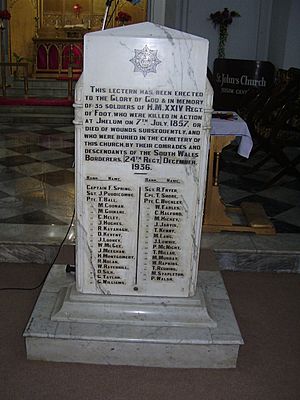
During the Mutiny of 1857, 35 British soldiers were killed at the Battle of Jhelum. They were fighting against rebelling soldiers from the East India Company. Among the dead was Captain Francis Spring. A marble lectern inside St. John's Church Jhelum lists the names of these 35 soldiers. St. John's Church is in the Jhelum Cantonment, next to the Jhelum River. It was built in 1860 and is still a famous landmark. It was a Protestant church used throughout the British period. After being closed for many years, it has been renovated and reopened.
A British soldier named William Connolly won a Victoria Cross for his bravery in this battle. Mirza Dildar Baig, also known as Khaki Shah, was part of the rebellion in Jhelum. He was later celebrated by Indian Nationalists. He was captured and executed near the Jhelum River. His grave is in a shrine in Jhelum Dildarnagar.
The railway bridge over the Jhelum River was built in 1873 by a British engineer, William St. John Galwey. During World War I, Jhelum District was the best at recruiting soldiers for the British war effort. Because of this, the British government gave more money to the area.
Independence of Pakistan
Most of the people in Jhelum were Muslim. They supported the Muslim League and the idea of Pakistan. When Pakistan became independent in 1947, Hindu and Sikh minorities moved to India. Muslim refugees from India then settled in Jhelum District.
City Administration
Jhelum city is the main city of Jhelum District. It is also the headquarters of Jhelum Tehsil. The city of Jhelum is divided into seven smaller administrative areas called union councils. These are Jhelum-I, Jhelum-II, Jhelum-III, Jhelum-IV, Jhelum-V, Jhelum-VI, and Jhelum-VII.
People and Population
| Jhelum city population | |||
|---|---|---|---|
| Census | Pop. | %± | |
| 1961 | 52,685 |
|
|
| 1972 | 70,157 | 33.2% | |
| 1981 | 106,462 | 51.7% | |
| 1998 | 145,847 | 37.0% | |
| Est. 2009 | 188,803 |
|
|
| Source: | |||
The population of Jhelum city was about 188,800 in 2012. It is the 32nd largest city in Pakistan by population. The city covers an area of about 22 km2 (8.5 sq mi). The population density is 261 people per square kilometer. The population growth rate is low compared to other cities in Pakistan.
Most of the people in Jhelum, about 98.47 percent, are Muslim. Among the smaller groups, Christians are the largest, making up 1.36 percent of the district's population.
Jhelum has one of the highest literacy rates in Pakistan. About 79% of people can read and write. This is higher than the average for Punjab province (58 percent). The literacy rate has grown a lot since 1981, when it was 38.9 percent. In urban areas, both males and females have much higher literacy rates. About 84% of the population has electricity, and 96% have access to water. Jhelum's Human Development Index is 0.770, which is one of the highest in Pakistan.
| Religious group |
1881 | 1891 | 1901 | 1911 | 1921 | 1931 | 1941 | 2017 | ||||||||
|---|---|---|---|---|---|---|---|---|---|---|---|---|---|---|---|---|
| Pop. | % | Pop. | % | Pop. | % | Pop. | % | Pop. | % | Pop. | % | Pop. | % | Pop. | % | |
| Islam |
11,369 | 53.86% | 7,373 | 57.25% | 8,322 | 55.66% | 10,470 | 53.21% | 10,816 | 59.89% | 13,980 | 59.49% | 19,416 | 58.5% | 185,323 | 97.3% |
| Hinduism |
7,966 | 37.74% | 4,250 | 33% | 4,350 | 29.1% | 5,824 | 29.6% | 5,379 | 29.78% | 6,304 | 26.83% | 8,936 | 26.92% | 50 | 0.03% |
| Sikhism |
1,460 | 6.92% | 1,064 | 8.26% | 2,074 | 13.87% | 3,029 | 15.39% | 1,497 | 8.29% | 2,581 | 10.98% | 3,950 | 11.9% | N/A | N/A |
| Jainism |
0 | 0% | 28 | 0.22% | 15 | 0.1% | 25 | 0.13% | 33 | 0.18% | 69 | 0.29% | 146 | 0.44% | N/A | N/A |
| Christianity |
N/A | N/A | 153 | 1.19% | 190 | 1.27% | 326 | 1.66% | 334 | 1.85% | 565 | 2.4% | 619 | 1.86% | 4,560 | 2.39% |
| Zoroastrianism |
N/A | N/A | 9 | 0.07% | 0 | 0% | 3 | 0.02% | 1 | 0.01% | 0 | 0% | N/A | N/A | N/A | N/A |
| Judaism |
N/A | N/A | 1 | 0.01% | 0 | 0% | 1 | 0.01% | 0 | 0% | 0 | 0% | N/A | N/A | N/A | N/A |
| Buddhism |
N/A | N/A | 0 | 0% | 0 | 0% | 0 | 0% | 0 | 0% | 0 | 0% | N/A | N/A | N/A | N/A |
| Ahmadiyya |
N/A | N/A | N/A | N/A | N/A | N/A | N/A | N/A | N/A | N/A | N/A | N/A | N/A | N/A | 533 | 0.28% |
| Others | 312 | 1.48% | 0 | 0% | 0 | 0% | 0 | 0% | 0 | 0% | 0 | 0% | 124 | 0.37% | 5 | 0% |
| Total population | 21,107 | 100% | 12,878 | 100% | 14,951 | 100% | 19,678 | 100% | 18,060 | 100% | 23,499 | 100% | 33,191 | 100% | 190,471 | 100% |
Geography and Climate
Jhelum is located at 32°56′ North latitude and 73°44′ East longitude. It is about a 1.5-hour drive from Islamabad, the capital of Pakistan. It is also about a 3-hour drive from Lahore, the heart of Punjab. Jhelum is connected to these cities by the National Highway N-5. Several other cities are within 1 to 2 hours' drive, including Gujrat, Gujranwala, Chakwal, and Mirpur, Azad Kashmir.
Jhelum has a humid subtropical climate. This means it is very hot and humid in summer. In winter, it is cold and usually dry. The highest temperature ever recorded between April and June was 49.2 °C (120.6 °F). In winter, the lowest temperature recorded was −0.6 °C (30.9 °F). The average yearly rainfall is about 850 millimetres (33 in). This amount is not enough because of the very high evaporation levels. However, during the rainy season, water flows very quickly from the north into the Jhelum River. This can damage crops, bridges, and roads. It also causes soil erosion in the district.
Over the years, global climate change has affected Jhelum. The charts below show the difference in rainfall between 1990 and 2015.
| Climate data for Jhelum, Pakistan | |||||||||||||
|---|---|---|---|---|---|---|---|---|---|---|---|---|---|
| Month | Jan | Feb | Mar | Apr | May | Jun | Jul | Aug | Sep | Oct | Nov | Dec | Year |
| Mean daily maximum °C (°F) | 19 (66) |
21 (69) |
27 (80) |
33 (91) |
38 (100) |
40 (104) |
36 (96) |
34 (93) |
34 (93) |
33 (91) |
27 (80) |
21 (69) |
30 (86) |
| Mean daily minimum °C (°F) | 4 (39) |
7 (44) |
12 (53) |
17 (62) |
22 (71) |
26 (78) |
26 (78) |
25 (77) |
23 (73) |
16 (60) |
9 (48) |
5 (41) |
16 (60) |
| Average precipitation mm (inches) | 35 (1.4) |
46 (1.8) |
45 (1.8) |
32 (1.2) |
27 (1) |
51 (2) |
223 (8.8) |
225 (8.9) |
79 (3.1) |
18 (0.7) |
12 (0.5) |
25 (1) |
81.8 (32.2) |
| Source: Weatherbase 2015 | |||||||||||||
| Climate data for Jhelum (1991-2020) | |||||||||||||
|---|---|---|---|---|---|---|---|---|---|---|---|---|---|
| Month | Jan | Feb | Mar | Apr | May | Jun | Jul | Aug | Sep | Oct | Nov | Dec | Year |
| Mean daily maximum °C (°F) | 18.9 (66.0) |
22.2 (72.0) |
27.4 (81.3) |
33.5 (92.3) |
38.7 (101.7) |
39.9 (103.8) |
36.1 (97.0) |
34.8 (94.6) |
34.6 (94.3) |
32.7 (90.9) |
27.3 (81.1) |
21.8 (71.2) |
30.7 (87.3) |
| Daily mean °C (°F) | 12.1 (53.8) |
15.4 (59.7) |
20.4 (68.7) |
25.9 (78.6) |
31.0 (87.8) |
33.0 (91.4) |
31.2 (88.2) |
— | 29.2 (84.6) |
25.1 (77.2) |
19.1 (66.4) |
14.0 (57.2) |
23.9 (75.0) |
| Mean daily minimum °C (°F) | 5.3 (41.5) |
8.5 (47.3) |
13.2 (55.8) |
18.3 (64.9) |
23.2 (73.8) |
26.0 (78.8) |
26.2 (79.2) |
25.8 (78.4) |
23.7 (74.7) |
17.5 (63.5) |
10.9 (51.6) |
6.3 (43.3) |
17.1 (62.8) |
| Average precipitation mm (inches) | 41.5 (1.63) |
58.6 (2.31) |
58.2 (2.29) |
43.5 (1.71) |
27.1 (1.07) |
67.3 (2.65) |
234.5 (9.23) |
235.0 (9.25) |
78.0 (3.07) |
22.9 (0.90) |
10.1 (0.40) |
16.1 (0.63) |
892.8 (35.15) |
| Average precipitation days (≥ 1.0 mm) | 3.9 | 4.9 | 4.9 | 4.8 | 4.0 | 5.8 | 12.0 | 10.4 | 5.5 | 2.3 | 1.2 | 1.4 | 61.1 |
| Mean monthly sunshine hours | — | — | — | — | — | 265.2 | 232.4 | 230.9 | — | — | 219.2 | 194.8 | — |
| Source: NOAA | |||||||||||||
Major Floods in Jhelum
The biggest floods in Jhelum happened in 1992. The city and nearby areas were almost completely covered by floodwaters.
Important Places to See
- Rohtas Fort: This is a strong fort built by the great Afghan king Sher Shah Suri. The fort is about 4 kilometers (2.5 miles) around. Qila Rohtas is located in a valley about 18 kilometers (11 miles) northwest of Jhelum. It is 7 kilometers (4.3 miles) from Dina.
- Old City: The old part of Jhelum has many narrow streets and busy markets.
- CMH Masjid Jhelum: This mosque is located across from the CMH (Combined Military Hospital) in Jhelum Cantonment.
- St. John's Church: This church was built in 1860 and is in the cantonment area.
- Zamir Jaffri Cricket Stadium: This stadium used to be called Gul Afshan Colony Stadium. It is now a cricket stadium where district-level tournaments are held. In October 2008, the Pakistan Cricket Board improved this stadium for bigger events.
- Altaf Park: This park was built in 1994–95 and is very close to the Cricket Stadium.
- Major Akram Shaheed Memorial Park: This park is about 100 meters (330 feet) from Shandar Chowk, in the center of the city. The Major Muhammad Akram Memorial Library is also in this park. A parade happens here every year on September 6th for Defence Day.
- Lehri Nature Park: This park is 10 kilometers (6.2 miles) from the G. T. Road. It is between Jhelum and Islamabad. The park is 30 kilometers (18.6 miles) from Jhelum and 90 kilometers (56 miles) from Islamabad. It is in the hilly Pothohar region.
- Mangla Dam: This dam is on the Jhelum River, about 30 km (19 mi) (18.6 miles) from Jhelum. It is the twelfth largest dam in the world. It was built in 1967. There is a place called Mangla View Resort nearby. It is a planned resort with homes, villas, hotels, and shops. The resort is on a 340-acre (1.4 km2) site near the Mangla Dam.
- Rasul Barrage: This barrage is on the Jhelum River, about 30 kilometers (18.6 miles) downstream from Jhelum. Two large water canals start here: the Rasul-Qadirabad link canal and the Rasul-Shahpur branch canal. The area around the Rasul Barrage lake is also a nice spot for picnics.
Getting Around Jhelum
- Auto Rickshaws: These are a common way to travel short distances within the city. Many new rickshaws use Compressed natural gas (CNG) instead of petrol. CNG is cleaner for the environment and cheaper.
- Taxis and Vans: Taxis and small vans that carry passengers are also available.
- Buses: Services like Daewoo Express connect Jhelum to other cities across the country.
- Railway: The Jhelum Railway Station was built in 1928 during British rule. Jhelum is on the main line of Pakistan Railways. It is connected to the whole country by train.
- Airports: The closest international airport is Islamabad International Airport. It is about 110 kilometers (68 miles) by road from Jhelum. Sialkot International Airport is about 100 kilometers (62 miles) from Jhelum. There is also a small airport called Gurha Salim Airport about 13 kilometers (8 miles) from the city center. It is used for military purposes, not for regular flights.
Sports and Recreation
- River-View Golf Club: This golf course is located in the city. National golf tournaments are often held here.
- Zamir Jaffri Cricket Stadium: This stadium hosts cricket and football tournaments at the district level. In October 2008, the Pakistan Cricket Board improved this stadium for bigger regional events.
Education in Jhelum
Jhelum has many schools and colleges. There are six colleges for women and ten for men that offer degrees. There are also six co-education colleges and six commerce colleges. The city has one law college and over 150 high schools.
The University of the Punjab has a campus in Jhelum. It is located near Rathiyan, Kala Gujran, and Satellite Town Jhelum. This campus offers programs in business, commerce, law, and computer science. New degree programs are expected to start soon. The Government of Punjab provided 65 kanals of land for this campus.
Jhelum also has two smaller campuses of the Virtual University of Pakistan. One is at Civil Lines, and the other is a private campus called Wings Institute of Learning. The Virtual University of Pakistan opened its own campus in Jhelum in March 2012. It is located in the middle of the city.
See also
 In Spanish: Jhelum para niños
In Spanish: Jhelum para niños





